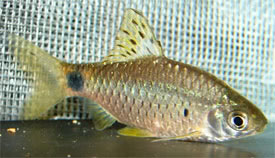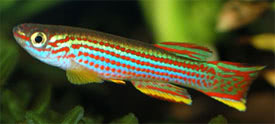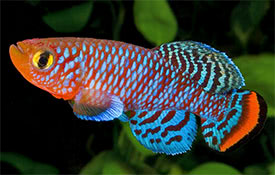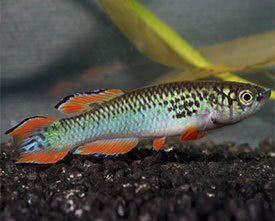Laubuka caeruleostigmata - Flying Minnow
 Magyarul / Hungarian
Magyarul / Hungarian

 Magyarul / Hungarian
Magyarul / Hungarian


- Scientific name: Laubuka caeruleostigmata
- Synonyms: Laubuca caeruleostigmata (Smith, 1931), Chela caeruleostigmata (Smith, 1931), Chela mouhoti (Smith, 1945), Laubuca mouhoti (Smith, 1945)
- Common name: Flying Minnow
- Group: Cyprinids
- Distribution: Asia; Laos, Thailand, and Cambodia; Mekong River, Chao Phraya and Mae Klong watersheds.
- Size: 5-7 cm
- Biotope: Inhabit main river channels and flooded forest areas where they usually form schools near the surface.
- Social behavior: Not an aggressive fish and can be kept in a community tank. It is a schooling species by nature so ideally should be kept in a group of at least 8-10 specimens.
- Diet: Omnivorous; In the nature they feed on terrestrial and aquatic invertebrates and their larvae, but in the aquarium they will eat all kinds of live and frozen foods along with good quality dried foods.
- Breeding: Quite easy
- Tank: Minimum 90 litres
- Population: 6-8 fish for 120 litres
- Decoration: Best kept in an aquarium that designed to resemble a flowing river with river sand or small gravel substrate, and decorate the tank with larger rocks that create lots of hiding places. The water-flow can be strong. The aquarium can be further decorated with aquarium plants which can be grown attached to the decor. They are intolerant to the accumulation of organic wastes, and require a high level of dissolved oxygen, therefore regular water changes are essential.
- Temperature: 20-26 °C
- pH: 6.0-8.0
- Hardness: 5.0-12.0 dGH
- Lifespan: 4-4 years
Description: Flying Minnow has a laterally flatted, high body with a silvery-olive base color that has a bluish sheen under certain lighting. The fish exhibit 4-5 short vertical blackish stripes on the side between the head and the dorsal fin. The fins are transparent, and the pectoral fins are much larger than the rest of the fins. They require a lot of swimming space, therefore an aquarium with base dimensions of 120x30 cm should be the smallest considered. Laubuka caeruleostigmata was once quite common in the ornamental fish trade, but is now rarely seen. In the nature they move back into large rivers in March or April at the very end of the flood cycle. Because of the habitat degradation and dam constructions on rivers, the fish is added to the IUCN Red List of Threatened Species as endangered.
Sexually mature females are fuller-bodied and usually grow slightly larger than males.
For breeding use a smaller 50 litres aquarium with a few clumps of fine-leaved aquarium plants, such as Java moss, where the water level should be only 10-15 cm high. Place 2 males and a female in the breeding tank, but the female should be placed in the setup one or two days prior to the introduction of the males. The male embraces the female, causing 30-40 eggs to be released, which the male will fertilize. The parents will not disturb the spawn. At 24 °C the fry hatch after approximately 24 hours and are free-swimming after an additional 3 to 4 days. The fry can be fed with newly hatched brine shrimp.
Sources:
https://www.fishbase.se/summary/6102
https://www.seriouslyfish.com/species/laubuka-caeruleostigmata
Aquarium Atlas Vol2.
https://www.aqvium.ru/ryby/karpovye/hela-golubovataya
https://www.fishbase.se/summary/6102
https://www.seriouslyfish.com/species/laubuka-caeruleostigmata
Aquarium Atlas Vol2.
https://www.aqvium.ru/ryby/karpovye/hela-golubovataya
Hasonló vízparamétereket igénylő fajok

























































